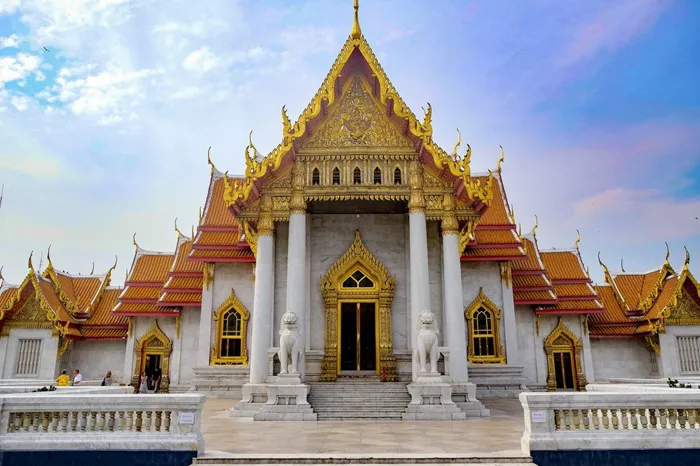Buddhist temples are sacred spaces that embody centuries of spiritual practice, cultural expression, and architectural evolution. From the ancient stone structures of India to the sleek, contemporary designs of today, these temples reflect the dynamic interplay between tradition and modernity. This article explores the characteristics, historical significance, and architectural developments of ancient and modern Buddhist temples, highlighting how they inherit traditional elements while embracing innovative designs.
Characteristics of Ancient Buddhist Temples
Architectural Styles and Materials
Ancient Buddhist temples often showcase architectural styles that are deeply rooted in the cultural and regional contexts of their time. For instance, Southeast Asian temples, such as those in Thailand, Myanmar, and Cambodia, are renowned for their ornate gabled roofs, gilded statues, and towering chedis (stupas). Wat Phra Kaew in Bangkok and Shwedagon Pagoda in Yangon exemplify this vibrant architectural heritage, featuring intricate carvings and expansive courtyards that invite contemplation and worship.
In contrast, Chinese Buddhist temples display a unique blend of traditional elements. These structures typically feature sweeping, curved roofs, wooden beams, and decorative tiles. The layout often includes multiple halls dedicated to various Buddhas and bodhisattvas, reflecting the hierarchical nature of Buddhist cosmology.
Cultural and Religious Significance
Ancient temples serve as more than just places of worship; they are cultural hubs that preserve and transmit religious teachings, art, and community practices. In China, temples like the White Horse Temple in Luoyang, established in the 1st century CE, are considered the cradle of Chinese Buddhism. Similarly, the Mahabodhi Temple Complex in Bodh Gaya, India, marks the site of Siddhartha Gautama’s enlightenment, making it a pivotal pilgrimage destination.
Characteristics of Modern Buddhist Temples
Architectural Innovations
Modern Buddhist temples often blend traditional architectural elements with contemporary design principles. This fusion results in structures that are both functional and symbolic. For example, the Jetavana Buddhist Temple in South Korea, designed by studio_GAON, presents a minimalist aesthetic that aligns with Buddhist asceticism. The uniformity and simplicity of the design encourage meditation and introspection, embodying the essence of Buddhist philosophy.
In urban settings, temples like the Hsi Lai Temple in California adopt traditional Chinese architectural styles but are designed to accommodate modern congregational needs. These temples often feature spacious halls, educational facilities, and community spaces, reflecting the evolving role of Buddhism in contemporary society.
Integration with Modern Life
Contemporary Buddhist temples strive to remain relevant in fast-paced, urban environments. Many incorporate sustainable design elements, such as solar panels and water conservation systems, aligning with Buddhist principles of mindfulness and respect for the environment. Additionally, these temples often serve as community centers, offering meditation classes, cultural events, and social services, thereby fostering a sense of community and belonging.
Inheritance of Tradition
Preservation of Religious Practices
Despite architectural innovations, modern temples uphold traditional Buddhist practices. Rituals, meditation sessions, and festivals continue to play a central role in temple life. For instance, the Nan Tien Temple in Australia, while adopting modern design elements, remains committed to traditional Buddhist teachings and ceremonies, serving as a bridge between cultures and generations.
Conservation of Cultural Heritage
Many modern temples actively engage in preserving cultural heritage by maintaining traditional art forms, scriptures, and educational programs. The integration of ancient artifacts into modern temple settings allows visitors to experience the richness of Buddhist history while appreciating contemporary interpretations. This synthesis ensures that the wisdom and beauty of ancient traditions are not lost but are instead reimagined for modern audiences.
Innovation in Design and Function
Adaptation to Contemporary Needs
Modern Buddhist temples are designed to meet the evolving needs of urban populations. The incorporation of multifunctional spaces allows for a variety of activities, from traditional ceremonies to modern art exhibitions. This adaptability ensures that temples remain vibrant centers of community life, attracting diverse groups seeking spiritual and cultural enrichment.
Dialogue with Modern Architecture
Architects and designers are increasingly engaging in dialogue with modern architectural trends, resulting in temples that are both innovative and respectful of tradition. The use of modern materials, such as glass and steel, alongside traditional stone and wood, creates structures that are visually striking and spiritually resonant. This dialogue between old and new fosters a dynamic architectural language that speaks to contemporary sensibilities while honoring ancient roots.
Case Studies
Wat Phra Kaew, Bangkok
Wat Phra Kaew, or the Temple of the Emerald Buddha, is a quintessential example of Thai temple architecture. Its intricate design, featuring gilded spires and detailed murals, reflects the zenith of Thai craftsmanship and religious devotion. The temple complex serves as a microcosm of Thai culture, encapsulating the nation’s history, art, and spirituality.
Shwedagon Pagoda, Yangon
The Shwedagon Pagoda is one of Myanmar’s most iconic religious structures. Its golden stupa, surrounded by numerous shrines and statues, stands as a testament to the enduring nature of Buddhist architecture. The pagoda’s design has influenced temple construction throughout Southeast Asia, inspiring variations that blend local traditions with Buddhist symbolism.
Hsi Lai Temple, California
Hsi Lai Temple, located in Hacienda Heights, California, exemplifies the global reach of modern Buddhist architecture. Designed to resemble a traditional Chinese temple, it serves as a cultural and educational center, offering programs that bridge Eastern and Western perspectives. The temple’s design incorporates elements such as pagodas, courtyards, and decorative tiles, creating an immersive experience for visitors.
Conclusion
The evolution of Buddhist temples from ancient to modern times illustrates a dynamic interplay between inheritance and innovation. While modern temples incorporate contemporary design elements and adapt to current societal needs, they remain deeply rooted in traditional Buddhist values and aesthetics. This balance ensures that Buddhist temples continue to serve as meaningful spaces for worship, community, and cultural expression, honoring the past while embracing the future.

